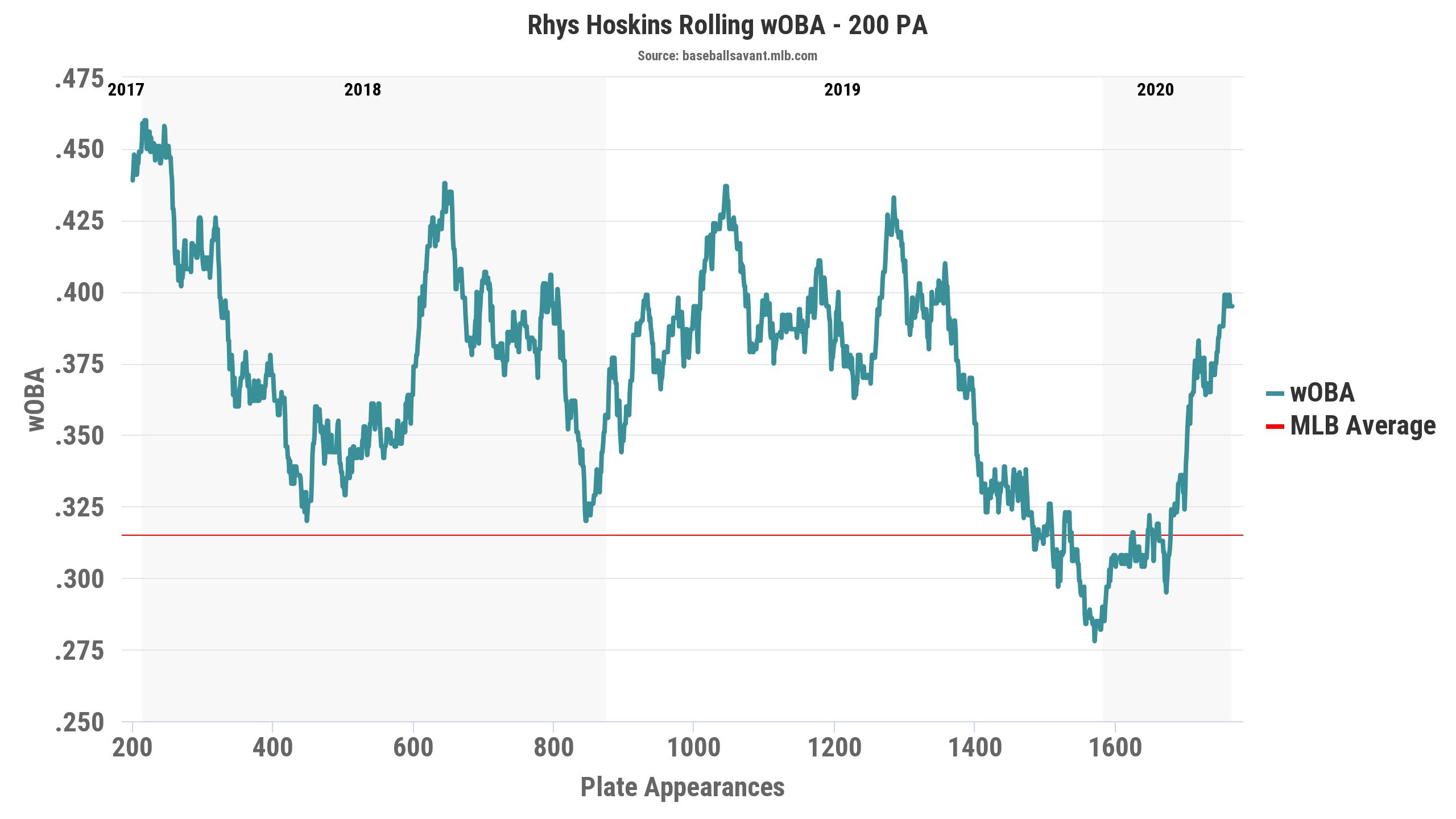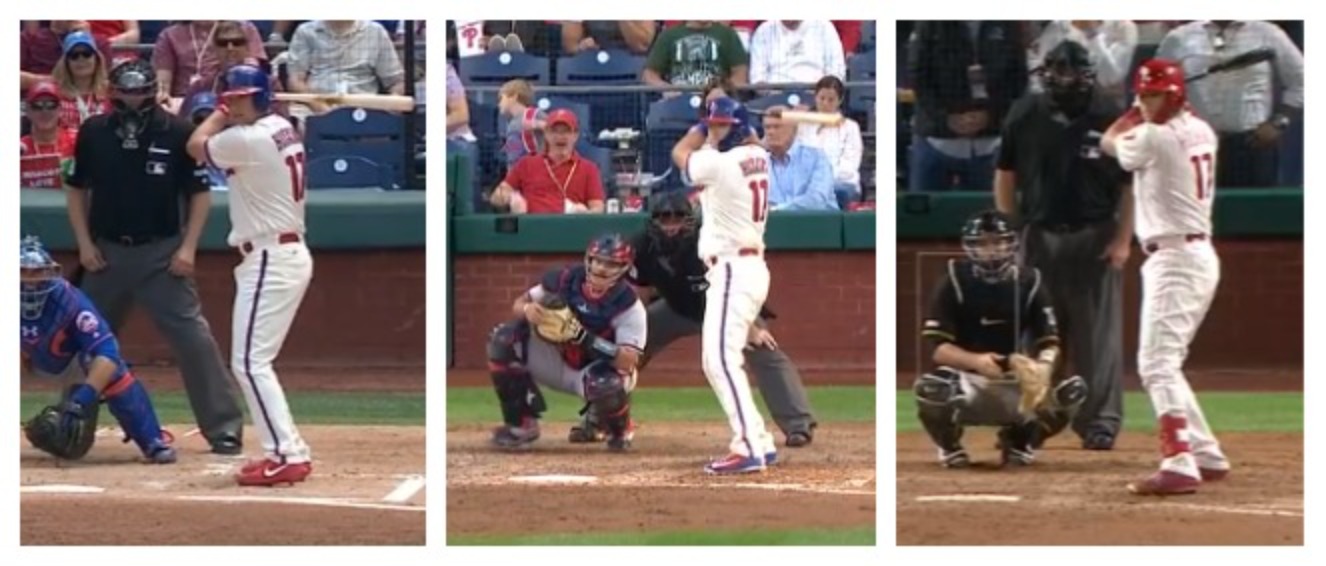The Philadelphia Phillies had a disappointing 2020, but one of the bright spots in an otherwise lost season was the resurgence of their seemingly lost first baseman, Rhys Hoskins.
Hoskins exploded onto the scene (quite literally) in 2017 when he hit 11 home runs in his first 22 games, and he quickly began to draw lofty comparisons. Fast forward a few years, and here we are, knowing full well that Hoskins is not the second coming of Ted Williams. Heck, in the second half of 2019 he looked more like the second coming of Chris Davis (the bad version, to be clear).
For a little while in 2020, it looked like the good Rhys Hoskins was lost once and for all. Although he’s known to be a streaky hitter, Hoskins had one of the worst stretches in baseball between the end of the 2019 season and the beginning of 2020. Over 282 PA, he put up a putrid .161/.302/.326 line while only hitting eight home runs. That is, uh, not good.
However, he began putting it together in mid-August and hit 10 home runs over a 25 game stretch before having his season ended by a freak UCL injury on his non-throwing arm. Despite his poor start, he ended the season with a respectable .245/.384/.503 line and .376 wOBA.
The question, then, is this: will Hoskins be able to return to form in 2021? My answer is yes—in fact, I think he might have his best season yet.
A New Approach
Okay, so Hoskins is a streaky hitter. That’s just one of his things. When he’s on, he’s really on, and when he’s not, he walks a ton. Since his debut, he’s 9th in BB% in the MLB. Even when he can’t hit the broadside of a barn, he’s good at working walks, which gives him a nice floor. We’ll come back to that.
Right now, I want to talk about that stretch from 2019 to early 2020. Sure, Hoskins is streaky, but this is a career-worst streak by, like, a lot.

During his entire career, Hoskins has never fallen below league average wOBA over 200 plate appearances except for that horrible stretch. So what gives?
Ultimately, it came down to two things: lack of confidence and mechanical changes. Exactly which of these came first, it’s hard to tell, but the two almost certainly played into each other. In a pretty lengthy piece by Matt Gelb of The Athletic, Hoskins’ lack of confidence and mechanical tinkering is detailed in-depth. Other writers have written about Hoskins’ swing change and its (bad) results as well.
Our very own Kyle Horton wrote about what went wrong for Hoskins during that second-half stretch of 2019, and he concluded (correctly) that Hoskins just needed to get back to his old ways and crush the ball to left field.
Hoskins is well-known as a pull-happy power-hitter (try saying that five times fast), but during that stretch in 2019, he strayed from those tendencies. Take a look at his first-half heat map versus his second-half heat map.
https://gfycat.com/oblongableaardwolf
As you can see, Hoskins tried to hit to the opposite field more, which sapped him of most of his power. In the previously mentioned article from The Athletic, Hoskins described it as getting away from his strengths, saying “I tried to chase what they [the pitchers] were doing.”
In 2020, Hoskins got back to his strengths in a big way.
A New (Old) Approach
Look, I get it. 41 games is a small sample size. I totally agree! This has been the challenge of the 60-game season, but that doesn’t mean we can’t glean things from the sample size anyway. We just need to temper our analysis.
Even in a small sample, there are things that can point to larger success in the future. I would argue that one of those things is a mechanical change, which Hoskins underwent—sort of.
Look at this at-bat from August 26th, 2019.
https://gfycat.com/organiclivealabamamapturtle
Hoskins makes note of this particular at-bat in his article with The Athletic, saying he noticed how his feet were closed off. He felt like this was throwing him off-balance and causing him to second guess himself. It seems he was right. I looked at video from every year of his career, and it seems that he got more and more closed off as time went on, likely to try and compensate for how frequently he is pitched outside. Look at his feet gradually shifting—the first picture is from 2017, the second from 2018, and the third from 2019.

Interestingly enough, Hoskins’ production dropped each year from 2017-2019.
| Season | Barrel % | Launch Angle | Sweet Spot % | XBA | XSLG | WOBA | XWOBA | XWOBACON | Hard Hit % | K % | BB % |
|---|---|---|---|---|---|---|---|---|---|---|---|
| 2017 | 13.5 | 18.4 | 39.7 | 0.260 | 0.564 | 0.417 | 0.403 | 0.460 | 45.2 | 21.7 | 17.5 |
| 2018 | 11.4 | 22.6 | 35.8 | 0.234 | 0.463 | 0.364 | 0.354 | 0.405 | 39.5 | 22.6 | 13.2 |
| 2019 | 9.7 | 23.9 | 31 | 0.221 | 0.429 | 0.347 | 0.344 | 0.387 | 38.7 | 24.5 | 16.5 |
With that in mind, take a quick look at this at-bat from September 7th, 2020.
https://gfycat.com/giantdismalamurminnow
Notice where his feet are? Looks a whole lot more like 2017 than 2019 to me. While this doesn’t seem like a huge change, it seems that it had an effect on the way Hoskins swung. The lower body is where a lot of power comes from, and for Hoskins that gradual shift in footing was enough to put a dent in his power production. Fly balls that typically landed over the fence were dying on the warning track.
If you’re following along, you won’t be surprised to find that despite the slow start to 2020, Hoskins produced better in 2020 than he has in any season since 2017.
| Season | Barrel % | Launch Angle | Sweet Spot % | XBA | XSLG | WOBA | XWOBA | XWOBACON | Hard Hit % | K % | BB % |
|---|---|---|---|---|---|---|---|---|---|---|---|
| 2020 | 14.8 | 24.8 | 32.4 | 0.238 | 0.512 | 0.376 | 0.368 | 0.412 | 42.6 | 23.2 | 15.7 |
While his walk rate dropped slightly, everything else saw a significant boost with his reformed stance. Again, small sample size aside, this is significant, especially when coupled with a few other changes he made to his approach.
More Aggressive, Better Results
Hoskins is known as one of the most patient hitters in the league. In 2018 and 2019, he led the league in pitches per plate appearance (4.44 and 4.59, respectively). He’s very good at drawing out at-bats and waiting on a pitcher to make a mistake. However, Phillies fans would be the first to tell you that it was exasperating at times to watch Hoskins let so many early strikes go by.
While Hoskins will never be an aggressive hitter (nor should he be), he did display a bit more aggression at the plate in 2020, seeing only 4.14 pitches per plate appearance.
| Season | Zone % | Zone Swing % | Zone Contact % | 1st Pitch Swing % | Swing % | Whiff % | Meatball % | Meatball Swing % |
|---|---|---|---|---|---|---|---|---|
| 2019 | 47.5 | 58.2 | 83.1 | 18.3 | 39.2 | 23.2 | 7.4 | 70.4 |
| 2020 | 49.7 | 61 | 79 | 24.3 | 41.5 | 26.6 | 8.2 | 73 |
Let’s break this down a little, because there’s some good and some bad. First, it’s not great that his zone contact fell, and his whiff rate rose. However, it IS nice to see Hoskins being more aggressive and not giving up easy strikes on the first pitch. Pitchers came in the zone more often against him, and he was able to make them pay for it. Overall, I like to see it if for no other reason than the confidence it displays, which was sorely lacking in 2019.
Plus, while his contact rate did fall, the quality of contact that he made was much better. This is evidenced by his increase in hard-hit and barrel rates. Additionally, I wouldn’t be surprised if he ends up on Alex Chamberlain’s Launch Angle Tightness Leaderboard for 2020.
Take a look at his launch angle gains.
https://gfycat.com/loneabsolutebighornsheep
Not only was Hoskins hitting the ball at a more consistent launch angle, but he was also hitting it more consistently at an optimal launch angle. I would say this bodes well for the future.
Hoskins made some strides against offspeed and breaking pitches as well.
| Year | Pitch Type | HR | SO | BA | XBA | SLG | XSLG | WOBA | XWOBA | EV |
|---|---|---|---|---|---|---|---|---|---|---|
| 2020 | Fastballs | 6 | 21 | 0.242 | 0.238 | 0.475 | 0.525 | 0.377 | 0.380 | 90.6 |
| 2020 | Breaking | 2 | 18 | 0.225 | 0.191 | 0.450 | 0.352 | 0.322 | 0.271 | 84.3 |
| 2020 | Offspeed | 2 | 4 | 0.333 | 0.399 | 0.917 | 0.934 | 0.536 | 0.557 | 96.3 |
| 2019 | Fastballs | 18 | 69 | 0.257 | 0.264 | 0.496 | 0.525 | 0.382 | 0.402 | 90.7 |
| 2019 | Breaking | 6 | 78 | 0.188 | 0.151 | 0.375 | 0.273 | 0.298 | 0.255 | 88.2 |
| 2019 | Offspeed | 5 | 26 | 0.169 | 0.169 | 0.437 | 0.322 | 0.273 | 0.239 | 86.9 |
While his production against fastballs remained almost identical, Hoskins saw marked improvement against both breaking and offspeed pitches. Of course, the breaking pitch numbers aren’t great either way, but it’s nice to see some improvement. Take the offspeed with a grain of salt because he only saw 65 of them all year, but improvement is improvement. Plus, he had only managed nine home runs off of 818 offspeed pitches his previous three seasons, so it’s nice to see him hit two against the 65.
The Bad
While I’m very optimistic about Hoskins for the future, I would be remiss if I didn’t note that Hoskins comes with some warts.
First, Hoskins is never going to be a .300 hitter. It’s just not in the cards. With that said, a career .366 OBP will play any day, especially in OBP leagues. Still, you would like to see that average closer to .260 than .230.
Additionally, Hoskins has some holes in his swing still. Here’s his 2020 zone chart by wOBA.

Hoskins has always had trouble with the high strike. In his career, he’s seen 956 pitches (12.1% of all pitches) in zones 1, 2, 3, 11, 12, and 13 (the upper heart and shadow of the strike zone). On those 956 pitches, he’s got a .189/.464/.294 line with a .319 wOBA, which is a far cry from his career .366 wOBA.
The issue is that his swing comes at such a steep angle that he rarely hits anything high in the zone squarely; rather, he ends up under the ball more often than not. This results in a lot of pop-ups and lazy fly balls. In fact, the majority of Hoskins’ contact is in the air, which is why his career BAPIP is .267.
Also, the UCL injury is some cause for concern and should be monitored. The news about his recovery is optimistic, but I’ll still be watching reports as the season draws nearer.
Wrapping It All Up
Here’s what it comes down to: current NFBC ADP has Hoskins going around 170. In the mocks I’ve seen so far, sometimes he goes even lower than that.
As you’re probably aware, first base isn’t a particularly deep position. At that value, I am all over Hoskins, and here’s why.
Let’s look at a quick comparison of 2020 numbers.
| Player | Barrel % | Exit Velocity | Launch Angle | Sweet Spot % | XBA | XSLG | WOBA | XWOBA | XWOBACON | Hard Hit % | K % | BB % |
|---|---|---|---|---|---|---|---|---|---|---|---|---|
| Hoskins | 14.8 | 89.8 | 24.8 | 32.4 | 0.238 | 0.512 | 0.376 | 0.368 | 0.412 | 42.6 | 23.2 | 15.7 |
| Player A | 13.1 | 88.9 | 15.2 | 37.5 | 0.284 | 0.593 | 0.387 | 0.374 | 0.461 | 40 | 23.1 | 7.3 |
The numbers look pretty similar. In particular, the xwOBA jumps out to me. Sure, Player A’s numbers are slightly better on paper, but they’re still pretty darn close. Who is Player A, you ask? It’s none other than the pinstriped home run king, Luke Voit, whose current ADP sits around 60. At over 100 picks later, I’d much prefer Hoskins.
Here’s another thing to consider: Hoskins has a high floor. Even in his very worst stretch, Hoskins is still getting on base consistently and scoring consistently. He’s never had a season with less than an 85 R/30 HR/85 RBI pace.
Small sample size aside, when a guy with that floor makes mechanical changes that appear to improve his production, I’m buying in. Am I saying Hoskins is going to hit 40 HR next season? Not definitely. Does he have the potential? Absolutely. At pick 170, I’m taking that bet.
Ultimately, there’s always the argument that this increase in production was nothing more than a hot streak in a shortened season. I’m open to that being a possibility. Even if it is, though, I doubt we ever see second-half 2019 Hoskins again.
Photo by Ian D’Andrea/Wikimedia Commons/flickr | Adapted by Doug Carlin (@Bdougals on Twitter)

